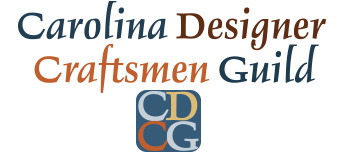Andree Richmond, Ceramic Artist
Andree Richmond, Ceramic Artist with studio in New Bern, North Carolina, creates fantastical animals, often wheeled or dancing, as in the struggle for balance between technology and natural rhythms. Narrative sculptures and commissions give her the opportunity to work on more complex pieces, whether in size, texture, detail or number of elements that make up the object.
Hand modeled earthenware sculptures using animalized human forms, animal or animal/human groupings comprise Andree’s work. She builds up surface decorations through successive firings, similar to painting, using both matt and gloss glazes, stains and lusters. When glazes seemed too restrictive to convey the subtle mood of some of the pieces, she has taken to treating the sculpture as a canvas to paint with oils.
Andree received the 2014 Cedar Creek Gallery Award at the 45th Annual Fine Designer Crafts Show in Raleigh.
Andree Richmond
Technology and the current economic system move us at breakneck speed separating us from our natural rhythms. Wooing us onto wheels to travel too fast to nourish our soul and sense of humor. My work is about my struggle for balance.
Animals are useful symbols for portraying non-verbals, for instance to me, cows are placid beasts that follow the crowd and are happy with the mundane, if their stomachs are full life is good and there is no reason to venture farther. As subject matter animals tend to be less threatening, therefore they can be used to caricature human traits and personalities.
Animals have a much higher degree of variety in their appearance and personality than humans. They also are much more straight forward than people typically are and can often be taken at face value. Using them as subject material allows me to access the deep subconscious and traditional symbolic power they convey.
Psychology, myth and animals swirl and blend in to my consciousness and I build the result.
The Making of Wheeled Animals
The wheeled animals start their life as two bowls, made by pinching a ball of clay thinner until it becomes a hollow shape, which varies depending on which animal I am creating. The body of the animals are made by joining the two shapes(bowls) together and they are paddled into shape. I then roll and attach lengths of clay to the body for legs.
While these are drying, I start modelling the neck and head. I usually work in sets of three. Going back to the body- legs I attach the axles for the wheels and carve the animal’s form from original the rough shape, when the body is complete I go back to the neck-head and scult the details, then attach it to the body.
Finally I sponge the entire piece to make it smooth for painting (this I believe is where the erroneous notion that my pieces are slipcast arose) The animal is then allowed to dry and is fired.
After washing the piece to remove any dust from the first firing, I paint the decoration with underglaze, brush glaze on top and refire. The wheels are then attached and the piece is complete.
Why the lids? I have always been partial to tins, boxes and secret compartments. I like the added complexity that an opening to the inside gives the piece. The best story I have heard for the lids, was given by a young boy to his mother, “that’s were you put the gas in.”





